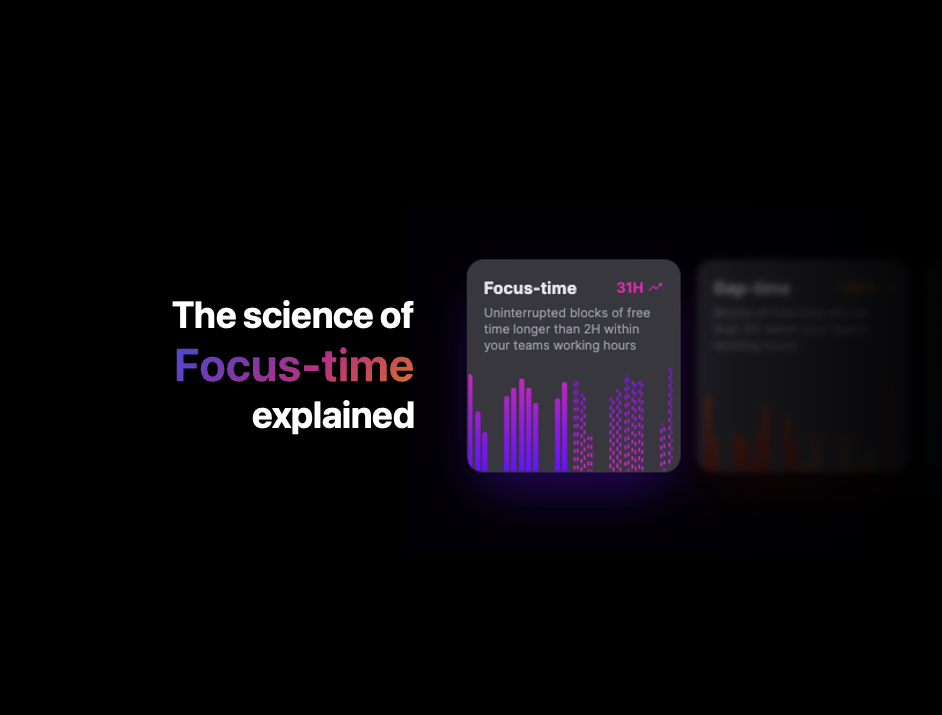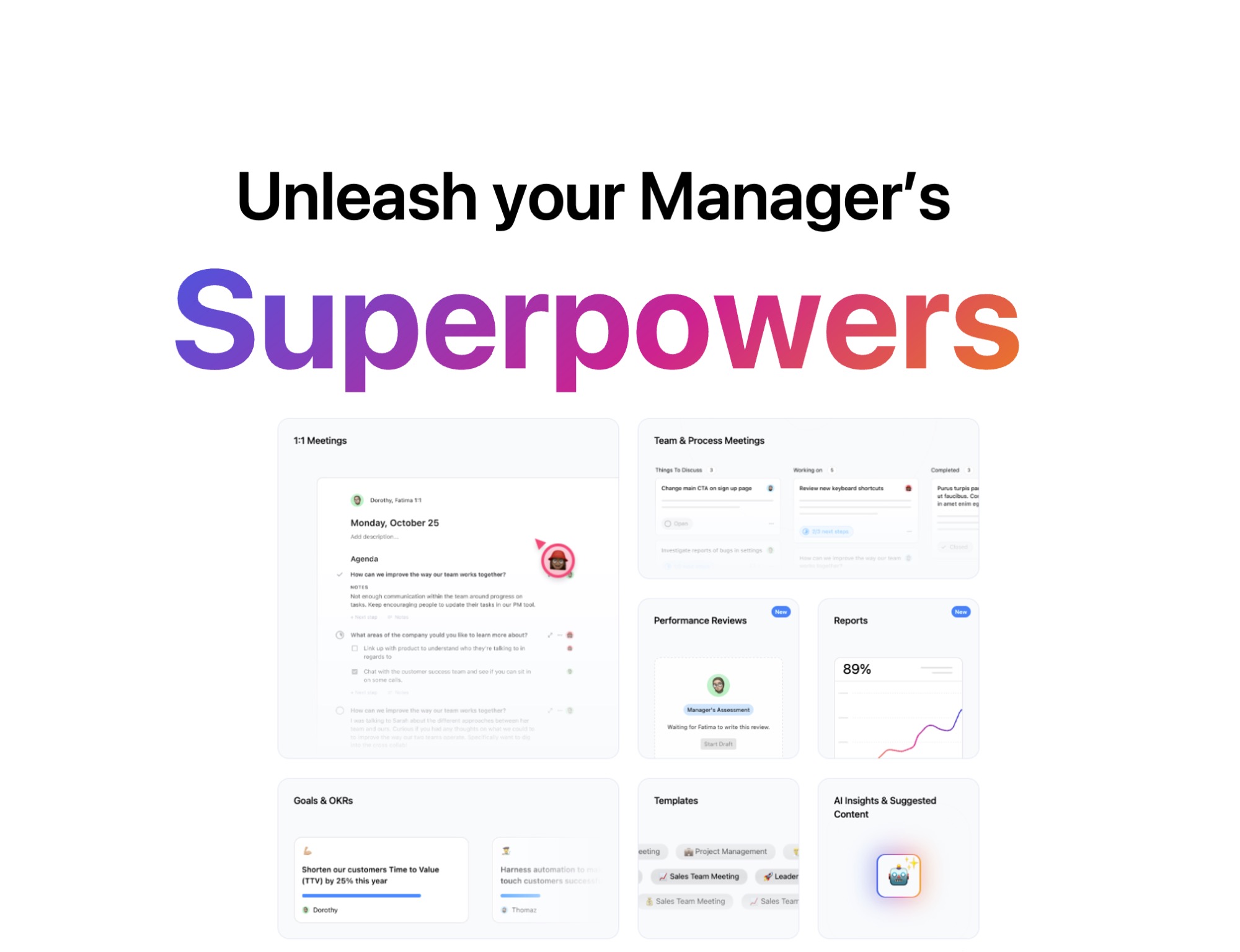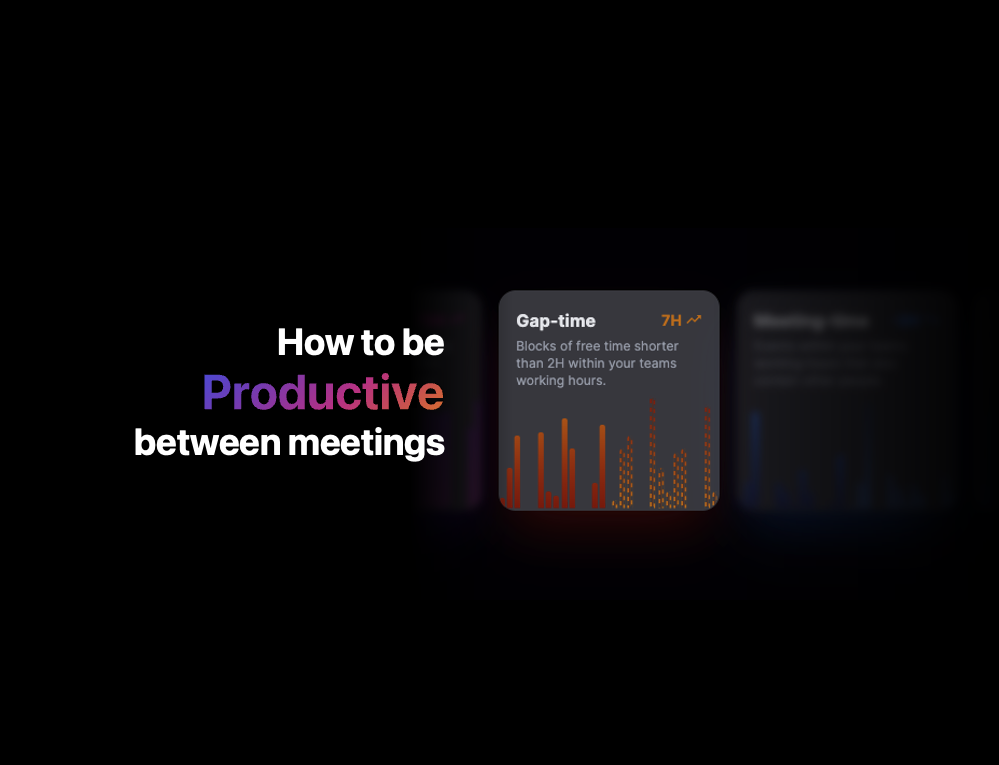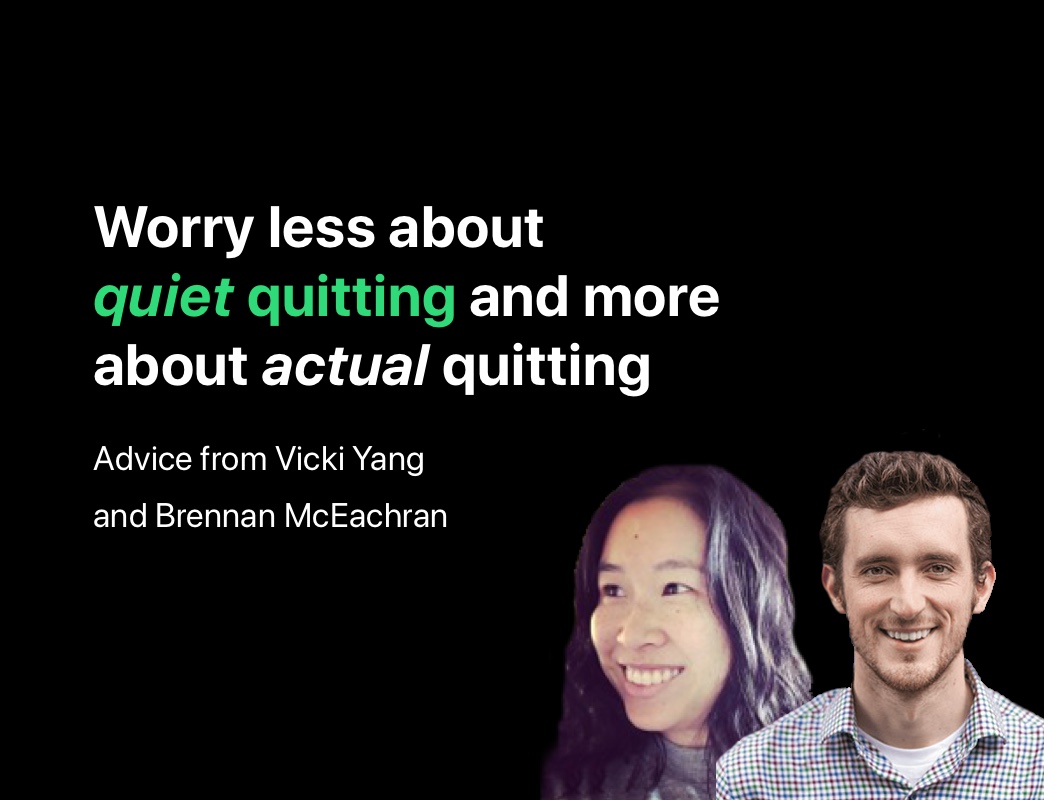Unlock the Power of Focus Time
11 min readMaximize productivity and achieve goals with focus time - dedicated periods of distraction-free work. In this post we explore the science and benefits of focus time, how to create more focus time, and where to find benchmarks.

Ever get the feeling that your calendar is running your life? That your meetings are preventing you from getting important work done? Do you crave getting into a flow state?
You need more focus time.
Researchers at the University of North Carolina surveyed 182 senior managers in various industries: 65% said meetings keep them from completing their work. While there was a 20% decrease in the average length of meetings during the pandemic, the number of meetings attended by employees on average rose by 13.5%. Add the distraction of inbound Slack messages and emails and it feels like there is no time to get things done.
We all feel the effects of too many meetings but it can be hard to quantify it for yourself and your team. Hypercontext exists to make time spent in meetings productive. To do that you need to structure your day to support your goals. If you are a manager that means looking at your team’s time as well.
In this blog post, we will cover the benefits of focus time, how to create more focus time, and the neuroscience of focus time.
- What is focus time?
- Why is focus time important?
- What are the benefits of focus time at work?
- What’s the science behind focus time?
- How much focus time do you need?
- How can you create more focus time for yourself and your team?
- Measure, monitor, and get focus-time benchmarks
What is focus time?
Focus time is a dedicated period of time (2+ hours) where you eliminate distractions to fully immerse yourself in a specific task or project. It has been shown to be a powerful tool for increasing productivity and achieving goals.
Focus time is a technique used to aid in achieving a “flow state” in workplaces. Csikzentmihalyi originally described nine main characteristics of flow in his seminal book on the topic.
Summarized, those characteristics are:
- There are clear goals and immediate feedback: we know what needs to be done and how well we are doing.
- Challenges are balanced with our skills: not too hard, not too easy.
- Action and awareness are merged: one-pointedness of mind is focused on the task.
- Distractions are excluded from consciousness.
- Worry of failure is absent: we have control over the task.
- Self-consciousness disappears: ego is set aside.
- Time is distorted: minutes may seem like hours.
- The activity becomes autotelic: it is an end in itself.
- The experience is enjoyable: the secret to a happy life is to learn to get flow from as many things we do as possible.
Knowing the above I’m sure you can see why flow state, and therefore focus time, are so desired by employees and companies alike.
Why is focus time important?
Focus time is invaluable for reducing distractions and increasing productivity, creativity, and problem-solving capabilities. It is an essential part of any successful workflow.
Distractions can come in many forms. Notifications, chats, or email have a significant impact on productivity. Researchers found it takes over 23 minutes to fully regain focus after a distraction and employees reenter their task with 20% more frustration and 30% more stress. (U of Cali. Irv.)
Meanwhile, focus time can allow people to reach a state of “flow”, or a state of peak productivity. McKinsey found these “flow states” were 5x more productive and that workplaces could double org-wide productivity if in flow.
Further, the Flow Genome Project found flow states can lead to a 6-8x increase in creative problem solving. Psychology Today reports that flow states not only vastly increase a person’s ability to solve problems, they’ve shown problem sets that participants were only able to solve in flow (solution rates of 40% in flow and 0% not in flow).
What are the benefits of focus time at work?
Establishing and respecting focus time is essential for high performing teams as it minimizes context switching, decreases interruptions, and increases the length of time in flow.
Focus time increases productivity
Research suggests one of the main benefits of focus time is increased productivity due to the cost of distractions, interruptions, and multitasking.
When you eliminate distractions and focus on a single task, you are able to work more efficiently and get more done in less time. This is because your brain is able to fully engage with the task at hand and you are able to maintain your concentration for longer periods of time.
Additionally, focusing on a single task allows you to make better use of your time and avoid the constant switching of tasks, which can lead to mental fatigue and decreased productivity. “Context switching”, or switching from one task to another, can be incredibly costly in terms of time and energy. APA reports it can take up 40% of our productive time at work.
Focus time improves mood, engagement, stress & frustration
A Humbolt & University of California, Irvine study measured the impact of interruptions against NASA mental workload measures: mental workload, stress, frustration, time pressure, and effort.
Compared to tasks with no interruption, tasks with the same context interruption resulted in a 10.83% increase in mental workload, 18.86% increase in stress, 38.45% increase in frustration, 15.30% increase in time pressure, and 16.31% increase in effort.
For tasks with different context interruption, there was an 11.50% increase in mental workload, 32.48% increase in stress, 35.76% increase in frustration, 10.67% increase in time pressure, and 20.53% increase in effort.
This indicates that interruptions can have a serious impact on employee productivity, morale, and efficiency, leading to increased costs for businesses.
Focus time helps you hit your goals and OKRs
Another benefit of focus time is that it allows you to achieve your goals & OKRs more effectively. When you have a clear and dedicated period of time to work on a specific goal, you are able to make more progress and achieve more than you would by constantly switching between different tasks or projects. This is because focus time allows you to fully immerse yourself in your work and make the most of your time and resources.
What’s the science behind focus time?
The neuroscience behind focus time is related to a concept called attentional control, which refers to the ability to focus on important information while ignoring irrelevant information. When you focus on a specific task, your brain is able to filter out distractions and direct your attention to the task at hand. This allows you to work more efficiently and effectively, and it also helps to reduce mental fatigue.
Research has shown that focus time can have a positive impact on your brain’s ability to learn and form new connections. When you focus on a task for an extended period of time, your brain is able to form new neural pathways, which can lead to increased learning and problem-solving abilities. Additionally, the act of focus can increase the release of a neurotransmitter called dopamine which can enhance your mood and motivation. This along with the benefits of focus time make it a powerful tool for personal and professional success.
How much focus time do you need?
According to research, you need 2+ hours of uninterrupted time to get into flow. Some people need more or less so be flexible as you test it out. On average, individual contributors have 15 hours per week of focus time.
Of course, the amount of focus time necessary to meet your goals varies by role. For instance, a salesperson may need (or want) less focus time than an engineer, Managers are expected to be in more internal meetings, etc.
For managers who are looking for ways to ensure their teams are getting enough focus time, Paul Graham’s “maker schedule/manager schedule” post is an excellent frame.
Mainly, it’s important to monitor focus time so you can benchmark and find ways to improve your balance of focus time. Increased awareness helps you identify risk of burnout or the potential for assigning stretch projects.
How can you create more focus time for yourself and your team?
To create more focus time in your day, one of the most effective strategies is to eliminate distractions. This can be done by creating a dedicated workspace, turning off notifications, and avoiding social media and other distractions while you work. Additionally, it can be helpful to set specific goals for your focus time and to break your work into manageable chunks, so that you can stay on track and maintain your concentration.
One effective strategy is to schedule your focus time at the same time each day. This will help you form a routine and make it easier for you to get into the zone and eliminate distractions. Additionally, setting realistic time limits on your focus time sessions will help you to stay on track and avoid overworking.
Tips for making more focus time on your calendar:
- Set other meetings at natural breakpoints (start/end of day)
- “Stack” meetings to each other to increase empty space in calendar
- Book focus time in your calendar (>2hrs) and flag those hours as “do not disturb.”
- Turn off notifications while they are in focus time.
- Make sure focus time work is High-IQ, High-EQ, and High-MQ work. Save other work for Gap time.
Tips for making more focus time for your team:
- Try “Wired in Wednesdays” Hypercontext does company wide days dedicated to getting in flow (no meetings, no need to respond to peers).
- Make sure everyone is aware of the importance of focus time and the expected outcomes.
- Have team members share their focus time goals with each other at the start of the day.
- Role model focus time to set the standard for the rest of the team.
- Designate a quiet, distraction-free area (in office) or email/slack status (remote) where team members can work without being interrupted.
Focus Time Scheduling Technique and Tools
In General, add it to your calendar
Block open gaps in your calendar for specific work that needs focus time. Add a description with your goal or series of goals for your focus time. That way, you’re sure to dedicate that time to a specific task. This is helpful for future you, and can also preempt coworkers from requesting you meet with them during it.
Don’t overschedule focus time for a task. Estimating time required is tough for complex tasks, so be sure you don’t give yourself too much time, or you’ll fill it. As Parkinson’s Law states, “work expands so as to fill the time available for its completion.”
During focus time, a Pomodoro timer might be a useful technique to start the process of getting into flow.
How to set focus time in Microsoft 365, Outlook, Teams, Viva Insights?
Let your calendar do the work for you to schedule focus time. Here are instructions for Microsoft.
How to set focus time in Google Calendar?
Use Google Calendar Focus time calendar event type to carve out time for deep work.
How to measure, monitor, benchmark focus time at work?
It’s essential to understand how much time is available for you and your team to spend on work that will drive success. All too often other people can crowd a team’s calendar with meetings and tasks that make focus time impossible.
With Hypercontext’s reporting, you can measure, monitor, and benchmark focus time on your team with unparalleled accuracy. By connecting to your calendar in one-click, Hypercontext is automatically set up to measure, monitor, and benchmark your time in a way that allows you to make adjustments to get more done and hit your goals.
Recap
Focus time is a powerful tool for increasing productivity, achieving goals, and improving mental focus and brain function. By eliminating distractions, setting specific goals, and scheduling focus time into your daily routine, you can make the most of this powerful tool and achieve more than you thought possible.
Time is a non-renewable resource so you need to use it wisely.
NEED MORE TIME TO GET THINGS DONE?







